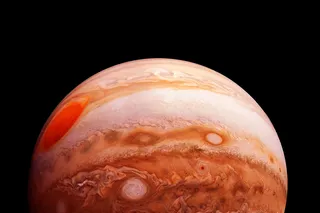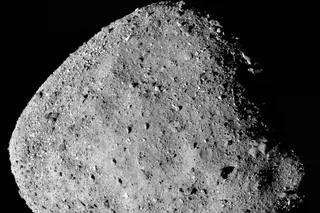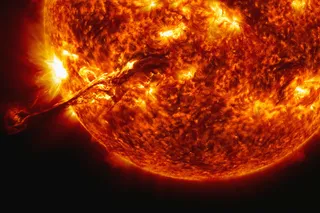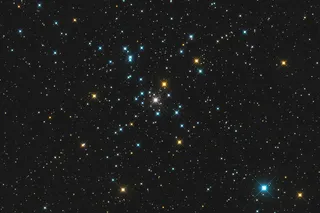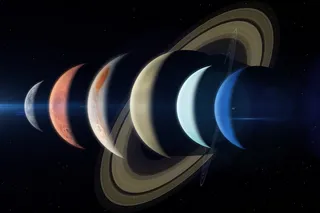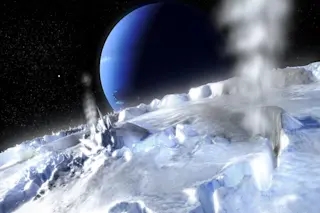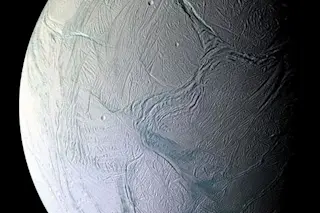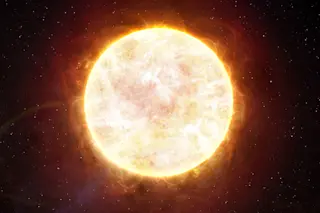Stephen Gaskell is a British science fiction writer whose work has been published in Nature, Interzone, and Clarkesworld. A graduate of the Clarion East writing workshop, he recently released Strata, co-written with Bradley P. Beaulieu.
In many ways the interior of a star would be an ideal place to live for an advanced species. A near limitless source of energy. Camouflage from interstellar predators. And sunshine three hundred and sixty five days a year.
In our new novella, Strata, Bradley P. Beaulieu and I didn’t travel so far into the future that humankind had migrated to the sun, but we did imagine giant solar mining platforms that orbit through the sun’s chromosphere. Of course, at present such a feat of engineering is beyond the technological and economic reach of humanity, but we wondered if this might one day be a scientifically feasible enterprise. Here are 10 features of the extremely hostile solar environment that had to be overcome:
1. Pressure
You might think your boss is putting you under enormous pressure for next week’s deadline, but it ain’t got a patch on the kind of stress that the center of the sun’s under. At its core, the pressure of the sun is equal to 340 billion times the Earth’s surface atmospheric pressure. That’s a lot of elephants standing on your head. Fortunately for the future of humankind’s solar mining adventures, the sun’s internal structure is not uniform. The outer regions from the photosphere up (the chromosphere and corona) are actually very thin, with pressures generally 1% or less of Earth’s surface atmospheric pressure. Still, I wouldn’t hang out there.
2. Gravity
The sun’s big. Big like you can’t imagine. You thought Jupiter was big, but the sun makes Jupiter look like some snotty-nosed Mummy’s boy on his first day at school. And what does all that matter do? It does what gravity tells it, creating one serious gravitational well about which the planets orbit like toy ducks around a discharging plughole. Mercury completes one whole orbit every eighty-eight days. The orbital period for a mining platform situated in the sun’s chromosphere would be around one-tenth of a day. That’s a fair zip! And there’s an additional problem; any solar miners would be effectively weightless in the freefall orbit—the mass of the platform being negligible compared to a planet or moon.
In a fixed position the problem would be worse, the surface gravity of the sun some 28 times greater than the Earth. Even fighter pilots get nowhere near those g-forces. In the best traditions of science fiction we came up with an as yet undiscovered technology: gravity inhibitors, an idea first floated (ahem) in H.G. Wells’ The First Men in the Moon with Dr. Cavor’s invention of the fictional material cavorite.
3. Solar storms
In a similar vein to the weather systems that dance around Earth, the sun has a complicated climate that brings all manner of different conditions to its atmosphere. One of the chief drivers of the sun’s weather are the intense magnetic fields that develop within sunspots, dark regions of lower temperature than their surroundings. These fields cause strong heating in the corona that can lead to turbulent entities such as coronal loops, spicules, solar flares, prominences, and most violently of all, coronal mass ejections that spew enormous quantities of matter and electromagnetic radiation into space, which can lead to devastating geomagnetic storms on Earth. Just as we have our favorite weathermen and weatherwomen, any giant artificial structure threading its way through the solar atmosphere will have a crew of helioseismologists scanning the skies for stormy weather ahead. And when they call lockdown, you listen!
4. Temperature
Oddly enough, one of the hottest places in the sun outside the inner zones is its outermost layer, the corona, which has average temperatures in excess of one million Kelvin. In contrast, the solar atmosphere is positively chilly, with a thin layer above the photosphere even dropping to the low four thousands. Okay, so it’s not time to stick on your winter thermals, but it does put the idea of platforms inside the sun in the conceivable, perhaps even the non-laughable, bracket. Are there any materials that might remain solid at this temperature? Why, yes there are! Although no elements can take this heat (tungsten with arguably the highest melting point gets sloppy at 3695 K), the snappily named tantalum hafnium carbide only melts at 4488 K. Of course, these figures are melting points under standard atmospheric conditions. Given the lower pressures in the chromosphere, these melting points would be appreciably lower inside the sun. However, there’s always ceramics…
5. Radiation
Radiation! Omigod, we’re all going to burn, our skin turning into a cancerous beach of pustulent sores before sloughing off like snake-skin, all the while vomiting ourselves into oblivion—
Slow down, slow down. Radiation, in its technical sense, simply means the emission of energy as electromagnetic waves or as high-speed subatomic particles. For ourselves, like the good bacteria and the bad bacteria that live within us, there’s good radiation and bad radiation. Gamma rays: bad. Light: good. Alpha particles: bad. Radio waves: Well, not exactly good, but not harmful either. The reason why radioactive waste is such a huge problem isn’t so much because of the radiation levels that such waste emits, but due to the longevity of the waste, with half-lives often in the thousands of years.
However, in order for humans to survive within the confines of the sun, extremely tough shielding will be needed. Even today NASA considers long-term moon activity to be seriously limited by present-day shielding technology, the biggest problem being the weight of lead needed, which would require an enormous amount of fuel to escape Earth’s gravity. The situation in the sun’s chromosphere would be orders of magnitude more difficult. We are largely safe from cosmic radiation on the surface of the Earth due to the planet’s magnetic field, which deflects particles away into space. Therefore we can speculate that force field technologies rather than material shielding will be key in the future.
6. Brightness
Although it’s an urban myth that Galileo went blind from studying the sun (he became blind at 72 from a combination of cataracts and glaucoma), terrestrial observation of the sun without the correct equipment and/or practices can lead to solar retinopathy. This kind of damage frequently results from sungazing during solar eclipses, a recurrent event that often sees large groups of corporate workers trudge outside their optimally lit office spaces to gawp in unison at an arc of fire that can sear retinal cells like flash steaks. Inside the sun, thermonuclear-rated sun shielding would be mandatory at all times.
7. Biosphere
As far as we know, there ain’t no life in the sun. That means no blackcurrant brambles, no jackrabbits, and no all-you-can-eat Tex-Mex restaurants. Energy prospecting in the sun wouldn’t be like the days of the Old West where you could hop on your horse, gallop out of town, and rustle up some critters for dinner with your trusty lasso. No sirree. Therefore unless we’re positing a future where humans can directly absorb the sun’s electromagnetic energy, much like in Adam Roberts’ novel By Light Alone, any permanently inhabited places inside the sun would either need to have a self-sustaining food source on board, or be regularly supplied from elsewhere. Given the difficulty of even getting into the sun’s chromosphere, the former seems the more likely. Dinner in the sun tonight—and every night—is going to have a staple component that is quick to grow, nutritious, and resilient. Something like cabbage.
8. Water
Stars might regularly crank out plumes of electrons and protons, and smaller quantities of heavier elements such as helium, oxygen, and even iron, during their solar flares, but water molecules just can’t hack it in the wild environment of the stellar interior. Therefore, there are two options for quenching that thirst when you work and play in the sun’s interior: bring the H2O along, and don’t forget to recycle; or create your own water as and when you need. Although the raw materials of water would be available in the solar environment, and the chemical reaction is well-known, the artificial production of water isn’t something that has been easy to do for Earth-bound scientists—hence the coming water wars—so maybe you should bring that urine-slash-water bottle with you.
9. Disease
Not so much a direct result of the hostile solar environment, but more a consequence of the need to be in a sealed structure combined with weakened immune systems and more virulent growth of bacteria, disease could be a huge issue for setting up shop in the sun. To combat major outbreaks of harmful diseases, any manned structure will have to have strict hygiene and quarantining procedures to ensure that any viruses are contained with minimal disruption to operations. Anybody who’s watched that classic episode of Red Dwarf knows how dangerous a mutated vindaloo can be!
10. Cabin Fever As well as having to overcome the harsh physical environment, any habitat that is off-Earth is going to have to deal with the unique psychological space that such a habitat brings. Already from observations of ISS astronauts we know that the combination of confined spaces, micro-gravity, and withdrawal from normal social relationships can cause conflict, irritability, loss of motivation, and sleep disturbances, to name but a few issues. In addition, these missions have identified the need for privacy as something essential to psychological wellbeing. Physical and mental stimulation are both recommended in such environments. In Strata, we envisioned the platforms as vast structures that would allow both social and private spaces. Then, to really give the crews something to get excited about, we gave them skimmer racing.


